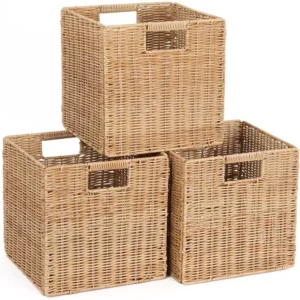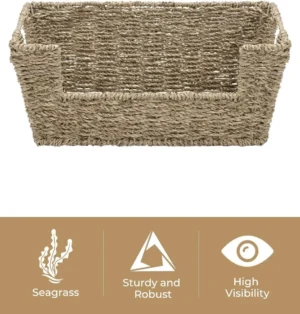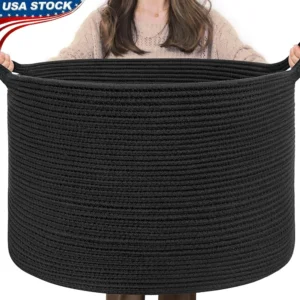1. Why Non-Toxic Cleaning Methods Matter for Your Basket Collection
Baskets made from natural materials like wicker, rattan, and seagrass aren’t just storage solutions—they’re beautiful décor elements that bring warmth and texture to any space. These handcrafted pieces deserve proper care to maintain their beauty and extend their lifespan. Unfortunately, many conventional cleaning products contain harsh chemicals that can damage these delicate fibers.
Traditional cleaning products often contain ingredients that pose multiple risks:
- Ammonia and bleach can weaken natural fibers, causing them to dry out, crack, and break
- Harsh chemicals strip essential oils from wicker and rattan, making them brittle
- Chemical residues can cause respiratory issues and skin irritation, especially for children and pets
- Runoff from these cleaners contributes to water pollution and environmental damage
By choosing non-toxic cleaning methods, you protect not only your valuable basket collection but also your family’s health and the environment. Natural ingredients effectively clean without compromising the integrity of basket materials—preserving both their beauty and functionality for years to come.
Throughout this guide, we’ll explore gentle yet effective cleaning solutions specific to each basket material in your home, ensuring your organizing laundry wicker baskets and decorative pieces remain beautiful and functional.
2. Essential Non-Toxic Cleaning Ingredients for Your Basket Care Toolkit
Creating an effective basket cleaning kit doesn’t require expensive specialty products. In fact, some of the most powerful cleaning agents for natural materials are probably already in your kitchen pantry. These simple ingredients harness the power of nature to clean, disinfect, and preserve your baskets without introducing harmful chemicals.
Here are the cornerstone ingredients for your non-toxic basket cleaning toolkit:
White vinegar: A natural disinfectant and deodorizer with acetic acid that fights mold and mildew. Its 5% acidity level is strong enough to kill bacteria but gentle enough for most basket materials.
Baking soda: Works as a gentle abrasive for stubborn stains while neutralizing odors. The fine granules help lift dirt from crevices without scratching fibers.
Castile soap: A vegetable-based soap that cleanses without harsh detergents. Its biodegradable formula is especially suitable for plant-based basket materials.
Lemon juice: Contains natural citric acid that brightens fibers and provides mild bleaching properties for light-colored baskets.
Essential oils: Beyond pleasant scents, many offer antimicrobial properties. Tea tree oil fights mold and mildew, while lavender adds fragrance with antibacterial benefits.
To complement these ingredients, you’ll need a few simple tools:
– Soft-bristled brushes (old toothbrushes work well for crevices)
– Microfiber cloths (lint-free for gentle wiping)
– Spray bottles (for applying homemade solutions)
– Soft cotton cloths (for drying)
The versatile ingredients in this toolkit will form the foundation for all the cleaning solutions we’ll discuss throughout this guide, suitable for various wicker baskets and other basket types in your home.
3. General Basket Cleaning Process: Preparing for a Safe Clean
Before diving into material-specific cleaning techniques, establishing a proper foundation for cleaning any basket is essential. This preliminary process helps prevent damage and ensures more effective cleaning results.
Follow these important steps before applying any cleaning solution:
Assess basket condition: Examine your basket for loose weaving, cracks, or previous damage that might require special care.
Empty completely and shake out: Remove all contents and turn the basket upside down outdoors to release loose dirt, dust, and debris.
Vacuum thoroughly: Use a brush attachment on low power to gently vacuum all surfaces, including between weaves and crevices. This crucial step prevents dust from turning into mud when moisture is applied.
Identify the material: Determine whether your basket is wicker, rattan, seagrass, fabric, or synthetic, as this will dictate the appropriate cleaning method (covered in upcoming sections).
Spot test: Before applying any cleaning solution to the entire basket, test it on an inconspicuous area to ensure it doesn’t cause discoloration or damage.
A critical caution for all natural fiber baskets: avoid over-wetting. Excessive moisture is the enemy of natural fibers, potentially causing warping, mold growth, and structural weakness. Always apply cleaning solutions sparingly using a damp—not wet—cloth.
After cleaning, proper drying is essential. Place baskets in a well-ventilated area with good air circulation, away from direct heat sources like radiators or sunshine, which can cause warping or fading. For baskets with more significant issues like mold infestations, our ultimate guide to removing mold from baskets provides detailed solutions.
4. Material-Specific Cleaning: Natural Wicker and Rattan Baskets
Wicker and rattan baskets showcase beautiful natural patterns and textures, but their porous nature presents unique cleaning challenges. These materials absorb moisture readily and can warp or develop mold if cleaned improperly.
For routine cleaning of wicker and rattan baskets:
Begin with dry cleaning using a soft brush to loosen dirt trapped between weaves.
For light soiling, prepare a gentle solution of 1 tablespoon mild castile soap dissolved in 2 cups warm (not hot) water.
Dip a soft cloth into the solution and wring thoroughly until barely damp.
Clean in the direction of the weave pattern, working with the natural flow of the material.
Avoid saturating the fibers—less moisture is always better for these materials.
For stubborn stains on wicker or rattan:
– Create a paste using baking soda and a small amount of water
– Apply directly to the stain using a soft toothbrush
– Gently scrub following the weave pattern
– Wipe away residue with a barely damp cloth
– Dry immediately with a clean towel
If your wicker appears brittle or dry after cleaning, consider conditioning:
– Apply a small amount of food-grade mineral oil or olive oil to a cloth
– Lightly wipe over the surface to restore some flexibility to the fibers
– Allow to absorb fully (24 hours) before using the basket
Always ensure thorough drying by placing baskets in a well-ventilated area for at least 24 hours after cleaning. Our selection of high-quality rattan baskets are crafted to withstand proper cleaning while maintaining their beauty for years.
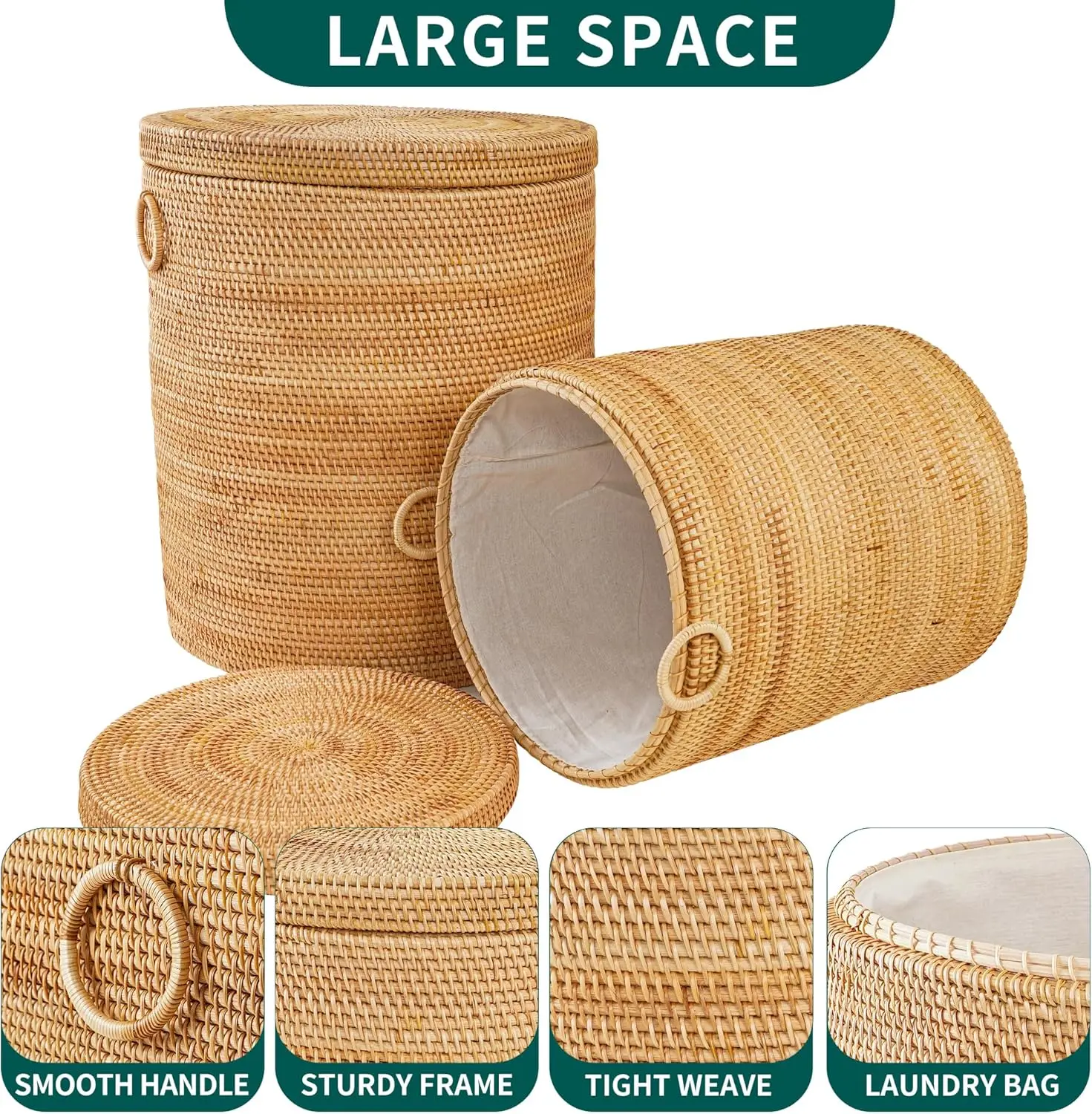
5. Material-Specific Cleaning: Delicate Seagrass and Water Hyacinth Baskets
Seagrass and water hyacinth baskets require extra caution during cleaning due to their highly moisture-sensitive nature. These natural materials can quickly deteriorate if exposed to excessive water, making preventative care and minimal-moisture techniques essential.
Important caution: Seagrass and water hyacinth are among the most water-sensitive basket materials—even more so than wicker or rattan.
For these delicate materials, focus on:
Preventative maintenance: Regular dusting and immediate spot cleaning prevent the need for deeper cleaning.
Dry cleaning priority: Use soft brushes and vacuum attachments with care, focusing on removing surface dust that can scratch and abrade fibers over time.
Minimal moisture approach: For necessary spot cleaning, create a solution of 1 part white vinegar to 4 parts water in a spray bottle.
Application technique: Instead of applying solution directly to the basket, lightly mist a microfiber cloth and gently dab the affected area. Immediately dry with a clean cloth.
Mold prevention: Occasionally place seagrass baskets in indirect sunlight for 15-20 minutes to help prevent mold growth. Avoid direct, harsh sunlight which can fade and dry out fibers.
Odor control: For musty smells, sprinkle a light coating of baking soda inside the basket, let sit overnight, and vacuum thoroughly the next day.
Visual indicators of water damage on seagrass include darkening, material softening, and structural weakness. If you notice any of these signs, immediately dry the basket and discontinue wet cleaning methods.
Our collection of woven storage baskets includes options that balance beauty with appropriate durability for your specific needs.
6. Material-Specific Cleaning: Fabric and Rope Baskets
Fabric and rope baskets bring a soft texture to home organization but require different cleaning approaches than their woven plant-fiber counterparts. The cleaning method varies significantly based on whether the fabric elements are removable or fixed.
For baskets with removable fabric liners:
– Check for care labels first—these provide the manufacturer’s recommended cleaning method
– Hand wash with mild dish soap and cool water when possible
– For machine-washable liners, use a gentle cycle with cold water and mild detergent
– Air dry completely before returning to the basket
For baskets with non-removable fabric:
– Spot clean using a solution of mild dish soap and cool water
– Apply with a soft cloth, working from the outside of the stain inward
– Rinse by dabbing with a clean, damp cloth
– Absorb excess moisture immediately with a dry towel
– Allow to air dry completely before using
Rope baskets require special attention:
– Clean using a cloth dampened with mild soapy water
– Focus on surface cleaning without saturating the rope
– Maintain the basket’s shape during cleaning to prevent distortion
– For cotton rope, be aware it may shrink slightly if over-wetted
Stain removal techniques:
– For grease: Apply dish soap directly to the stain before general cleaning
– For water-based stains: Diluted white vinegar can be effective
– For unknown stains: Baking soda paste applied for 15 minutes before wiping clean
Preventing mildew in fabric baskets is critical—ensure complete drying in a well-ventilated area before storing or using. For more organization ideas using various basket types, explore our guide on effortless laundry organization with wicker baskets.
7. Material-Specific Cleaning: Plastic and Synthetic Baskets
Plastic and synthetic baskets offer greater cleaning flexibility compared to natural materials. These durable options can withstand more thorough cleaning without risk of water damage, though non-toxic methods still protect your home environment.
Advantages of synthetic materials include:
– Higher moisture resistance
– Less susceptibility to mold and mildew
– Ability to withstand more rigorous cleaning
For routine cleaning of plastic or synthetic baskets:
Prepare an all-purpose non-toxic cleaner by mixing:
– 1 cup warm water
– 1/4 cup white vinegar
– 2 teaspoons castile soap or dish soap
– 5-10 drops essential oil (optional, for fragrance)Apply with a cloth or soft brush, reaching textured surfaces and corners
For disinfecting synthetic baskets naturally, use undiluted white vinegar, spray lightly, and allow to air dry
For specific issues with synthetic baskets:
- Scuffs and marks: Make a paste with baking soda and water, apply with a soft cloth, and rub gently
- Discoloration in white/light baskets: Create a solution of 1/4 cup lemon juice to 1 cup water, wipe surface, and rinse with clear water
- Textured surfaces: Use an old toothbrush dipped in soapy water to reach crevices, then rinse with a damp cloth
Unlike natural fibers, synthetic baskets can be rinsed more thoroughly if needed—just avoid using water hot enough to potentially warp plastic (keep below 120°F). Our selection of wicker laundry baskets includes both natural and synthetic options to suit your specific needs.
8. DIY Non-Toxic Cleaning Solutions: Recipes for Every Basket Need
These homemade cleaning formulas provide effective solutions for various basket cleaning challenges while keeping your home free from harsh chemicals.
Standard All-Purpose Basket Cleaner
Perfect for routine cleaning of most basket types
– 2 cups warm water
– 1 tablespoon castile soap
– 5 drops tea tree or lemon essential oil (optional)
– Mix in a spray bottle, apply to cloth (not directly on natural baskets)
– Store up to 1 month at room temperature
Deep Cleaning Solution
For sturdier baskets with built-up grime
– 1 cup water
– 1 cup white vinegar
– Juice of half a lemon
– Mix in a spray bottle, use sparingly on natural fibers
– Make fresh for each use for best results
Mold and Mildew Removal Paste
For spot treatment of problem areas
– 2 tablespoons baking soda
– 1 teaspoon white vinegar
– Few drops of water to form paste
– Apply with soft toothbrush, let dry 30 minutes, brush off
– Use immediately after mixing (will lose effectiveness quickly)
Natural Basket Brightener
For lightening discolored natural fibers
– 1/4 cup lemon juice
– 1 cup warm water
– Mix and apply with cloth to light-colored baskets
– Test on inconspicuous area first
– Store refrigerated up to 1 week
Deodorizing Powder
For freshening baskets between cleanings
– 1 cup baking soda
– 10 drops essential oil (lavender, lemon, or cedar)
– Mix in jar, sprinkle in basket, let sit overnight, vacuum
– Store in sealed container up to 3 months
Conditioning Oil for Brittle Natural Fibers
For dry, brittle wicker or rattan
– 2 tablespoons olive oil or food-grade mineral oil
– 10 drops lemon essential oil
– Mix in small jar, apply sparingly with cloth
– Store at room temperature up to 6 months
For baskets that require regular organization and cleaning, explore our selection of best wicker baskets for laundry organization to find options that suit your space and style.
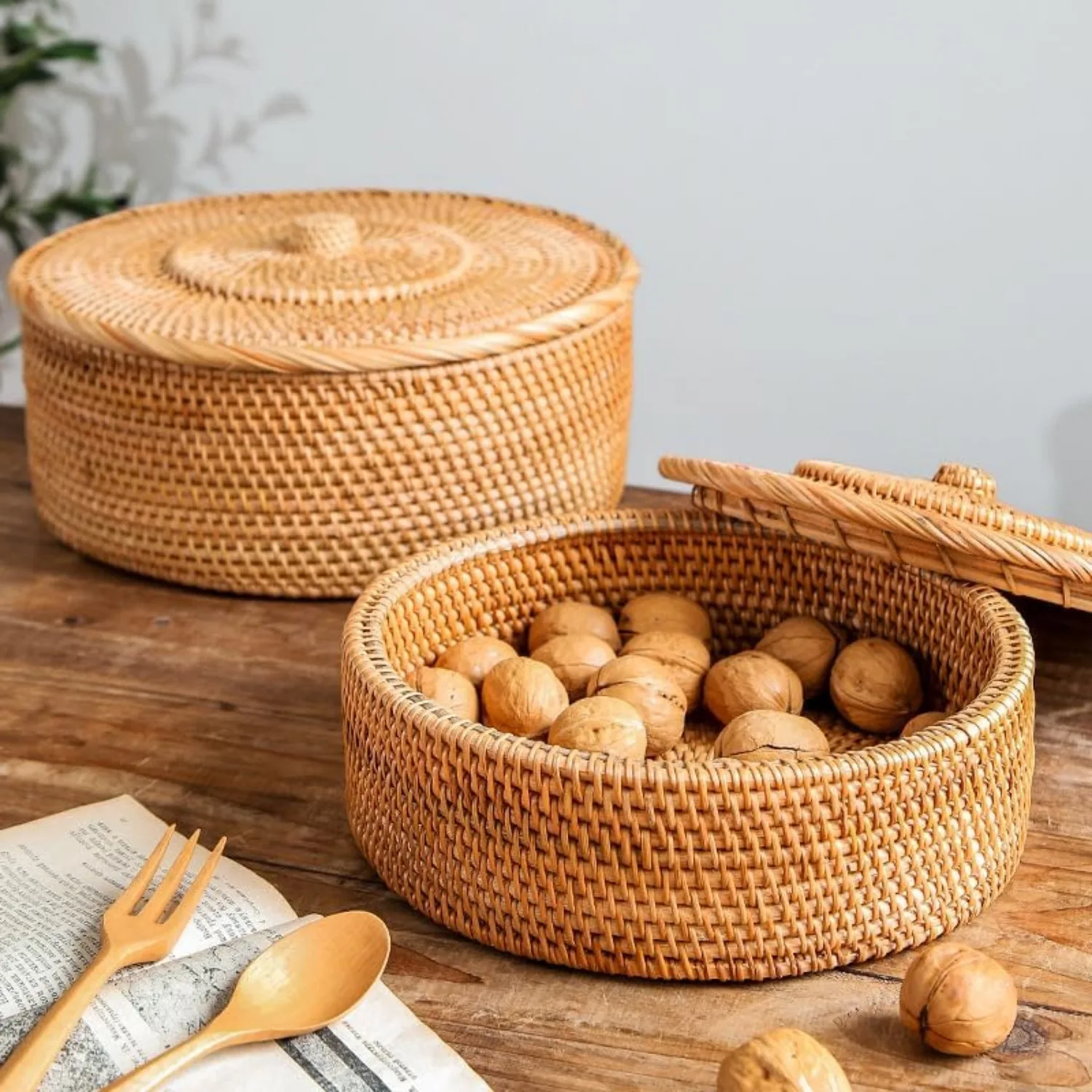
9. Tackling Tough Basket Problems: Mold, Stains, and Odors
Even with regular maintenance, baskets sometimes develop challenging issues that require specific treatment approaches. Here’s how to address common problems while maintaining a non-toxic cleaning approach.
Mold and Mildew
Mold appears as dark spots or fuzzy patches and requires immediate attention:
1. Take the basket outdoors to prevent spore spread
2. Apply undiluted white vinegar with a soft cloth
3. Allow to sit for 30 minutes (the vinegar smell will dissipate as it dries)
4. Brush gently with a soft brush
5. Dry thoroughly in well-ventilated area with good air circulation
6. For persistent mold, a second application may be necessary
Food Stains
Kitchen basket stains require different approaches based on type:
– Oil-based stains: Apply a paste of baking soda and water, let sit 1-2 hours, brush off
– Tomato/berry stains: Lemon juice solution applied with cloth, then rinsed
– Coffee/tea stains: Equal parts vinegar and water, blot gently
Odor Elimination
For baskets with persistent smells:
– General mustiness: Sunshine and fresh air for 1-2 hours (avoiding direct harsh sunlight for natural fibers)
– Pet odors: Baking soda sprinkled liberally, left overnight, then vacuumed thoroughly
– Food odors: Vinegar-water solution (1:1) applied lightly, dried completely
Water Damage
If your natural fiber basket has been soaked:
1. Blot excess water immediately with absorbent towels
2. Reshape carefully while damp
3. Allow to dry completely in well-ventilated area (may take 2-3 days)
4. Once dry, assess for mold and treat if necessary
Sticky Residue
Remove without harsh chemicals:
1. Apply olive oil to a cloth
2. Gently work into the sticky area
3. Wipe clean with a solution of castile soap and water
4. Dry immediately
Our wicker storage baskets collection offers quality options for various storage needs, all of which benefit from these cleaning techniques.
10. Preventative Care: Keeping Baskets Clean and Fresh Between Deep Cleans
Establishing good preventative practices significantly reduces the need for intensive cleaning and extends the life of your baskets. These simple habits help maintain the beauty and functionality of your basket collection.
Implement a regular dusting schedule
– Weekly light dusting prevents buildup that can become embedded in fibers
– Use a soft cloth or vacuum with brush attachment on low powerStrategic basket placement
– Keep baskets away from high-humidity areas like bathrooms (unless specifically designed for these spaces)
– Avoid placing natural fiber baskets in direct sunlight, which can fade and weaken fibers
– Elevate baskets off basement floors where moisture may accumulateUse protective liners
– Insert washable fabric liners or even coffee filters in the bottom of baskets that hold potentially messy items
– For food storage baskets, use parchment paper liners that can be easily replacedHandle with clean hands
– Natural oils from hands can transfer to basket fibers over time
– Wash hands before handling decorative baskets, especially light-colored onesSeasonal care schedule
– Spring/Fall: Deep clean all baskets
– Summer: Check for increased mold risk in humid conditions
– Winter: Monitor for excessive dryness that may cause brittlenessProper storage for seasonal baskets
– Clean thoroughly before storing
– Store in climate-controlled areas (avoid attics and basements when possible)
– Place acid-free tissue paper inside to maintain shape
– Cover with cotton sheets rather than plastic to prevent moisture buildupHumidity considerations
– Optimal humidity for natural fiber baskets: 40-60%
– Use a dehumidifier in damp spaces
– Consider a small humidifier in extremely dry environments
For more ideas on optimal basket placement and storage, our guide on wicker laundry basket storage ideas provides practical solutions that help maintain basket condition.
Black Wicker Baskets, Rattan Storage Baskets, Tall Wicker Baskets, Wicker Shelf Baskets, Woven Storage Baskets
5-Tier Distressed Black Wood Frame Storage Tower with Removable Wicker Baskets for Home Organization$715.80 Select options This product has multiple variants. The options may be chosen on the product pageWicker Laundry Baskets, Woven Laundry Baskets, Woven Storage Baskets
$392.02 Select options This product has multiple variants. The options may be chosen on the product pageRattan Shelf Baskets, Rattan Storage Baskets, Small Wicker Baskets, Square Wicker Baskets
Square Plastic Wicker Storage Baskets Set of 3 with Collapsible Design for Cube Storage Organization$185.47 Select options This product has multiple variants. The options may be chosen on the product pageWicker Baskets with Handles, Wicker Storage Baskets, Woven Storage Baskets
$137.92 Select options This product has multiple variants. The options may be chosen on the product pageLarge Wicker Laundry Baskets, Tall Wicker Baskets, Woven Laundry Hampers, Woven Storage Baskets
$130.54 Select options This product has multiple variants. The options may be chosen on the product pageWicker Blanket Baskets, Woven Laundry Baskets
$89.60 Select options This product has multiple variants. The options may be chosen on the product page
11. Can You Sanitize Baskets Naturally? Safe Disinfection Methods
Many homeowners wonder if natural cleaning methods can truly sanitize baskets effectively. The good news is that several non-toxic approaches can significantly reduce germs and bacteria without harmful chemicals.
First, it’s important to understand the difference between general cleaning and true sanitization:
– Cleaning removes visible dirt, dust, and some germs
– Sanitizing reduces bacteria to levels considered safe by public health standards
Natural sanitizing methods that work for most baskets include:
White Vinegar Spray
– Mix equal parts white vinegar and water in a spray bottle
– Lightly mist (don’t saturate) the basket surface
– Allow 10-15 minutes of contact time for effective germ killing
– Wipe with a clean cloth and allow to dry completely
– Particularly effective for synthetic baskets and sturdy natural fibers
Sunlight Exposure
– UV rays naturally kill many bacteria and mold spores
– Place baskets in direct sunlight for 2-3 hours
– Rotate to ensure all surfaces receive exposure
– Note: For natural fiber baskets, limit exposure to prevent fiber damage and fading
Steam Cleaning (For Appropriate Materials)
– Hold a handheld steamer 6-8 inches from synthetic baskets
– Move continuously to avoid heat concentration
– The high temperature kills most bacteria and dust mites
– Important: Only suitable for plastic and synthetic baskets—never use on natural fibers
Hydrogen Peroxide (3%)
– Apply to a cloth and wipe surfaces
– Effective against a broader spectrum of germs than vinegar
– No need to rinse—breaks down into water and oxygen
– Test on inconspicuous area first, especially for colored baskets
Our collection of wicker baskets with lids offers excellent options for storing items that require a higher level of cleanliness, with the lids providing additional protection from dust and contaminants.
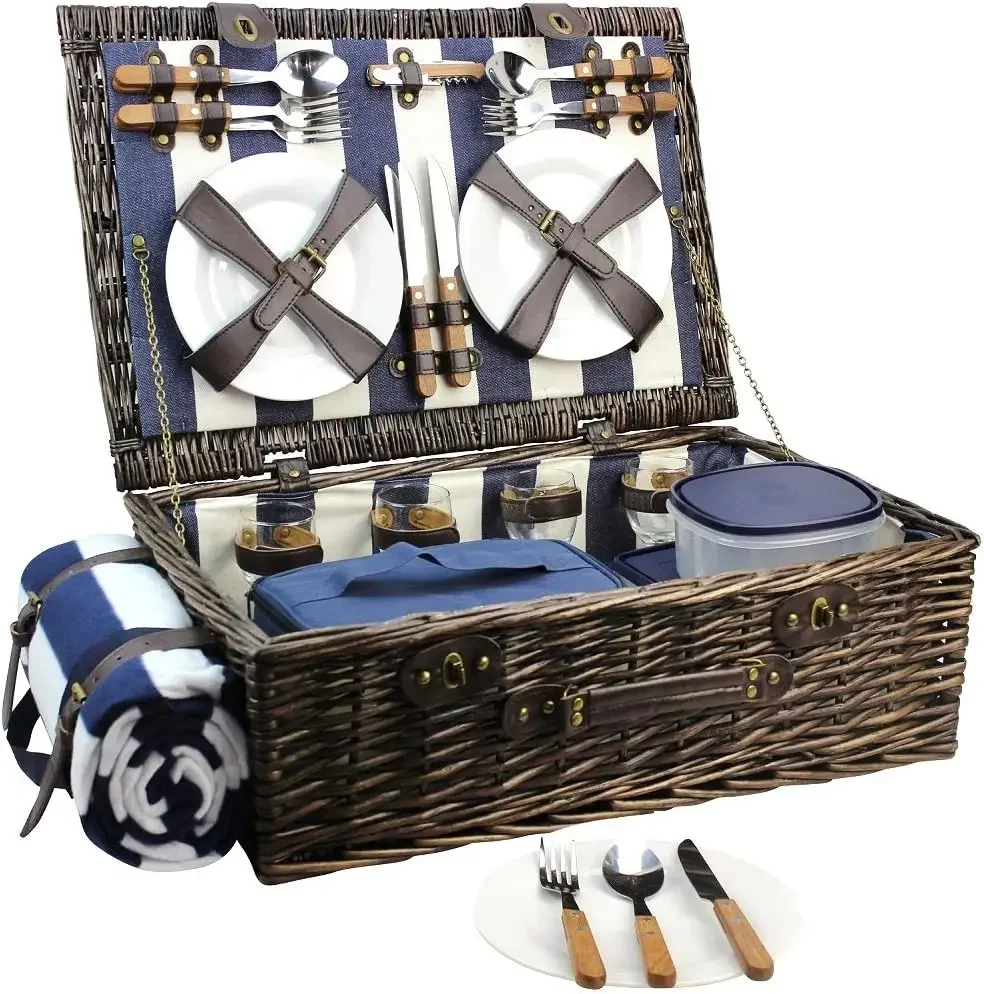
12. Are Commercial “Natural” Basket Cleaners Worth It?
While DIY solutions are effective and economical, some commercial non-toxic cleaners can offer convenience and specialized formulations. Understanding what to look for helps determine if store-bought options are worth the investment.
When evaluating commercial “natural” cleaning products, consider:
What Makes a Truly Non-Toxic Commercial Cleaner:
– Third-party certifications (Green Seal, USDA Organic, EcoLogo)
– Full ingredient disclosure (not just “natural fragrance”)
– Free from ammonia, phosphates, synthetic dyes, and artificial fragrances
– Biodegradable formula
Greenwashing Warning Signs:
– Vague terms like “eco-friendly” without specifics
– Hidden ingredients listed as “fragrance” or “cleaning agents”
– Missing certification logos
– Excessive plastic packaging despite “green” claims
Cost Comparison: DIY vs. Commercial
– DIY vinegar solution: approximately $0.10 per ounce
– DIY castile soap mixture: approximately $0.25 per ounce
– Commercial “natural” cleaners: $0.50-$1.50 per ounce
When Commercial Products Might Be Worth It:
– Time constraints make convenience a priority
– Specific basket materials need specialized formulas
– Professional-grade results required for high-value baskets
– Preference for ready-to-use products with specific scents
Tidy Treasure carefully selects our basket collections to ensure they respond well to both DIY and quality commercial cleaning products. For those wondering about material durability in everyday use, our article on whether wicker baskets are good for laundry provides helpful insights on material performance and maintenance.
13. How Often Should Different Basket Types Be Cleaned?
Establishing appropriate cleaning schedules for different basket types helps prevent damage from either neglect or over-cleaning. This guide provides general recommendations that can be adjusted based on your specific usage and environment.
| Basket Type | Regular Maintenance | Deep Cleaning | Special Considerations |
|---|---|---|---|
| Kitchen wicker/rattan | Weekly wipe-down | Monthly | Food residues require prompt attention |
| Decorative display baskets | Dusting every 2 weeks | Quarterly | Less frequent if purely decorative |
| Bathroom storage | Weekly surface cleaning | Bi-weekly | Higher humidity requires more frequent checks |
| Laundry baskets | Empty and inspect weekly | Monthly | Check for moisture from damp clothes |
| Toy storage | Weekly shake-out | Monthly | Sanitize more frequently during illness |
| Picnic/food baskets | After each use | Before and after storage | Ensure complete drying before storing |
| Seagrass/water hyacinth | Dusting every 2 weeks | Quarterly (minimal moisture) | Most susceptible to water damage |
| Fabric baskets | Shake out weekly | Every 2-3 months | Machine wash (if applicable) only when visibly soiled |
Visual indicators it’s time to clean (regardless of schedule):
– Visible dust accumulation
– Spots or stains
– Musty or unpleasant odors
– Discoloration developing
– Signs of mold (dark spots)
Baskets in humid environments (above 60% humidity) generally require more frequent cleaning and inspection for mold, while those in very dry climates may need conditioning more often to prevent brittleness. Our collection of wicker baskets with handles offers convenient options for regular use that still maintain their beauty with proper care.
14. When Professional Help Is Needed: Caring for Antique or Valuable Baskets
While most basket cleaning can be handled with DIY methods, certain valuable or antique pieces may require professional expertise. Knowing when to seek professional help can prevent irreparable damage to treasured items.
Identifying Truly Valuable or Antique Baskets:
– Historical significance or provenance
– Unusual or intricate weaving patterns
– Native American, African, or Asian traditional techniques
– Signed by known basket makers
– Authentic antiques (generally 100+ years old)
– Rare materials or exceptional craftsmanship
Warning Signs DIY Cleaning Could Cause Damage:
– Structurally unstable areas or loose weaving
– Previous repairs that appear fragile
– Materials you cannot confidently identify
– Very old, brittle, or discolored fibers
– Museum-quality or investment-grade pieces
– Ceremonial or culturally significant items
Questions to Ask Before Hiring a Professional:
– What experience do you have with my specific basket type?
– What cleaning methods do you use?
– Are your techniques reversible and non-damaging?
– Can you provide references or examples of similar work?
– Do you offer documentation of the condition before and after?
– What guarantees do you provide if damage occurs?
What Professional Cleaning Typically Includes:
– Detailed assessment and documentation
– Specialized cleaning using conservation-grade materials
– Stabilization of weakened areas
– Custom storage recommendations
– Appraisal information (sometimes)
For those looking to properly care for high-quality storage pieces, our wicker storage baskets with lids collection provides options that combine beauty with protection for valuable contents.
15. Is It Safe? Common Questions About Non-Toxic Basket Cleaning
As you implement natural cleaning methods for your baskets, you might have questions about safety and effectiveness. Here are answers to frequently asked concerns:
Is vinegar safe for all basket materials?
While vinegar is generally safe for most basket materials when properly diluted and applied sparingly, its acidity (pH around 2.5) can potentially damage very delicate or antique natural fibers if overused. Always test on an inconspicuous area first and never soak natural fibers in vinegar solutions.
Can essential oils damage natural fibers?
When used in small amounts (5-10 drops per cup of cleaning solution), most essential oils are safe for basket materials. However, some oils like cinnamon and clove can be more acidic and potentially discolor light fibers. Citrus oils are generally safe but may cause fading with repeated use on colored baskets.
Will natural cleaning be effective against persistent mold?
For light to moderate mold, vinegar solutions and sunlight exposure are quite effective. However, deep-set black mold that has penetrated fibers may require multiple treatments. If natural methods don’t resolve the issue after 2-3 attempts, the basket may be beyond salvaging, especially if the mold has weakened the structural integrity.
Are non-toxic methods safe for baskets that store food?
Yes, the non-toxic methods in this guide are food-safe when baskets are thoroughly dried after cleaning. For direct food contact (like bread baskets), stick to vinegar, lemon juice, and food-grade hydrogen peroxide solutions, and ensure complete drying before use.
How do I know if my basket is colorfast before cleaning?
To test colorfastness, dampen a white cloth with your cleaning solution and gently rub an inconspicuous area of the basket. If any color transfers to the cloth, the basket is not colorfast and should only be cleaned with plain water or specialized products designed for such materials.
Can I speed up drying time safely?
While it’s tempting to use hairdryers or heaters, forced heat can warp natural fibers. Instead, improve air circulation with a fan positioned nearby (not directly on the basket) and ensure good ventilation. This speeds drying without risking damage.
For more information about caring for specific basket types, our rattan storage baskets collection includes care instructions tailored to these durable yet beautiful storage options.




